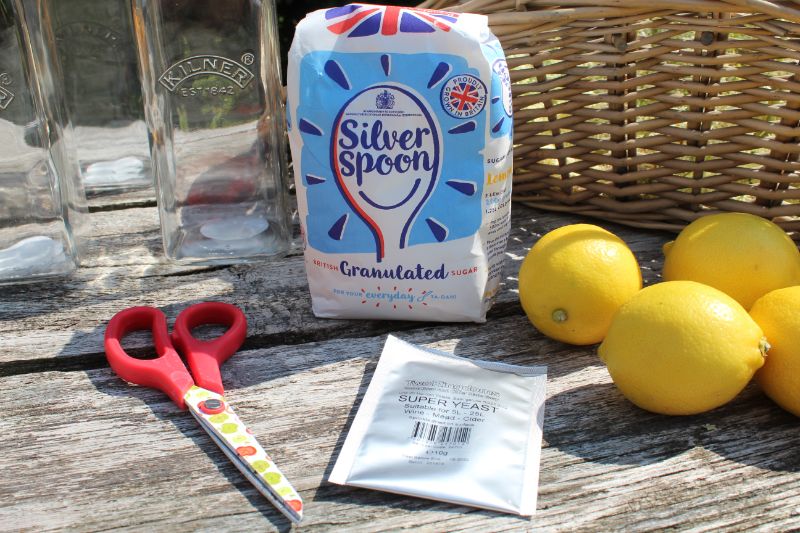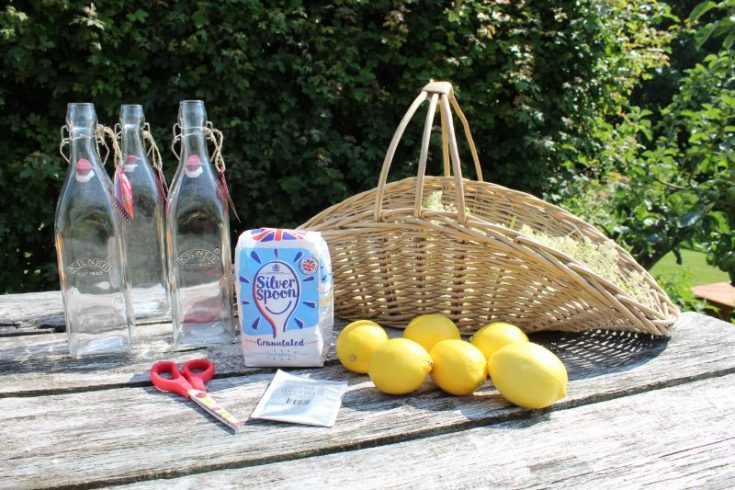Quick and Easy Elderflower Champagne Recipe – Around May and June (depending where you live) you will often see elderflowers in bloom, by the sides of the road and in field hedgerows. Take advantage of this bounty to make your very own sparkling elderflower wine! Here is what it looks like, if you are a bit unsure. The flower-heads are quite flat and the bush itself has a distinctive scent (not entirely pleasant and a little reminiscent of cat pee!). However, elderflower champagne is delicious and a lovely treat for later in the year. Once you have the equipment then this recipe costs very little for lots of lovely fizz! If you fancied making a non-alcoholic version too, we have a recipe for Elderflower Cordial.
Ingredients for Elderflower Champagne
16 heads of elderflower
1kg Sugar
4 lemons – unwaxed for zesting and juice
5g Dry Champagne Yeast
A 10 Litre sterilised fermenting bucket (preferably with airlock lid)
Sterilised muslin
Bottles (either heavy one specifically for Prosecco/Champagne, or plastic fizzy soda/pop bottles)

How to Make Elderflower Champagne
- Pick around sixteen elderflower heads from the hedgerow. Choose open blooms and avoid those with brown flowers if possible.


- Add your sugar to 2 litres of freshly boiled water, stirring until fully dissolved.

- When the water has cooled pour it into your sterilised fermenting bucket, add 6 litres of cold water.


- Clean up the elderflower with a good shake, removing any brown flowers, leaves or insects. Then, using a fork, strip the flower-heads from the stems. It looks a bit like porridge once you start doing it (and takes ages!). I got fed up of using the fork to strip the flowers and did a sort of ‘rubbing’ motion that you use to make crumble!

- Add the lemon juice and zest, elderflowers and Champagne yeast to your bucket.

- Stir the mixture, put on the lid with the airlock (or balance the lid loosely if it does not have an airlock) and leave for 5-6 days, stirring once a day.
- Sieve the mixture through a muslin and then decant into bottles using a funnel. I bought lots of lovely Kilner swing top bottles for this, but have since been advised against this in case the bottles explode! You can reuse old Prosecco or Champagne bottles (the heavy ones, not regular wine bottles) and finish with corks and cages that you can buy online. Or you can decant into fizzy soda/pop bottles with a screw lid. Not quite as pretty, but very practical.
- The Champagne will continue to ferment in the bottle, so it’s a good idea to open the screw top lid slightly for a few days to stop too much build up of fizz.
Elderflower Champagne Recipe

A lovely seasonal Elderflower Champagne Recipe for fresh elderflowers in May and June.
Ingredients
- 16 heads of elderflower
- 1kg Sugar
- 4 lemons - unwaxed for zesting and juice
- 5g Dry Champagne Yeast
- A 10 Litre sterilised fermenting bucket (preferably with airlock lid)
- Sterilised muslin
- Bottles (either heavy one specifically for Prosecco/Champagne, or plastic fizzy soda/pop bottles)
Instructions
- Pick around sixteen elderflower heads from the hedgerow. Choose open blooms and avoid with brown flowers if possible.
- Add your sugar to 2 litres of freshly boiled water, stirring until fully dissolved.
- When the water has cooled pour it into your sterilised fermenting bucket, add 6 litres of cold water.
- Clean up the elderflower with a good shake, removing any brown flowers, leaves or insects. Then, using a fork, strip the flowerheads from the stems.
- Add the lemon juice and zest, elderflowers and Champagne yeast.
- Stir the mixture, put on the lid with the airlock (or balance the lid loosely if it does not have an airlock) and leave for 5-6 days, stirring once a day.
- Sieve the mixture through a muslin and then decant into bottles using a funnel. I bought lots of lovely Kilner swing top bottles for this, but have since been advised against this in case the bottles explode! You can reuse old Prosecco or Champagne bottles (the heavy ones, not regular wine bottles) and finish with corks and cages that you can buy online. Or you can decant into fizzy soda/pop bottles with a screw lid. Not quite as pretty, but very practical.
- The Champagne will continue to ferment in the bottle, so it's a good idea to open the screw top lid slightly for a few days to stop too much build up of fizz.
